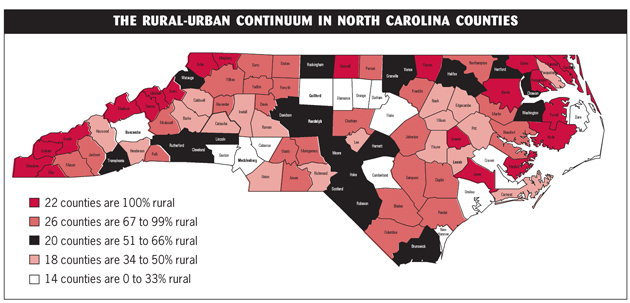 |
 |
 |
©
2007 Jordan Institute
for Families

Vol.
12, No. 3
June 2007
How Rural Is North Carolina?
How rural is North Carolina? Your answer to this question depends in large part on how you define “rural.” Here we will use the U.S. Census Bureau’s classification, which is based on total population and population density.
According to this definition, any place that is not urban is rural. Thus, you live in a rural place if it does not fit into any of the following categories:
- Urban generally means there is at least one block group or census block with a density of 1,000 people per square mile, with surrounding blocks of . . .
- Urbanized areas, densely settled territories that contain 50,000 or more people, and/or . . .
- Urban clusters, densely settled territories that have at least 2,500 people but fewer than 50,000.
Based on this, North Carolina is nearly twice as rural as the national average: 39.8% of our state’s population can be classified as rural, compared to 21.0% of the U.S. population (US Census Bureau, 2003a).
Though this “either/or” definition has its uses, many researchers find it more helpful to think in terms of a rural/urban continuum with five categories:
- 100% rural
- More than 2/3 rural (66.7 to 99.9%)
- More than 1/2 rural (50.1 to 66.6%)
- More then 1/2 urban (33.3 to 50.0% rural)
- More than 2/3 urban (0 to 33.3% rural)
The figure below illustrates the rural/urban continuum in North Carolina today.

As you can see, most of our entirely rural counties are situated in the West (mountains) and East (coastal plain). We also have 26 counties that are more than two-thirds rural scattered across the state.
Using the rural/urban continuum, the Rural Success Project has reached some interesting conclusions about the performance of North Carolina’s county child welfare agencies. For more on this, click here.
Although NC is much more rural than the national average, even in our most rural counties we find population densities greater than in many Western U.S. states. This means that often rural child welfare practice in NC is really about working with families and children in small towns. (For more on this click here.)
